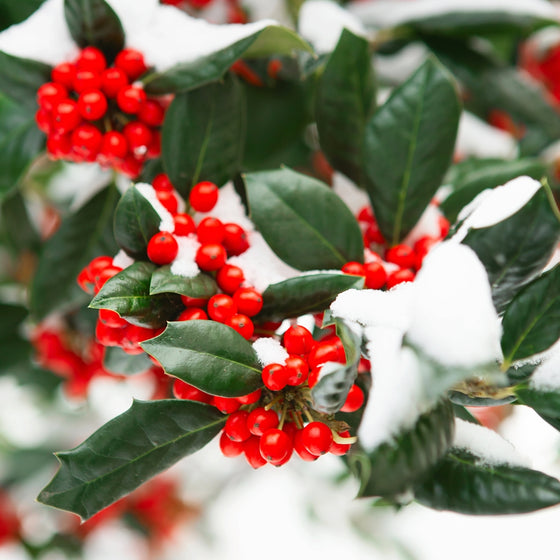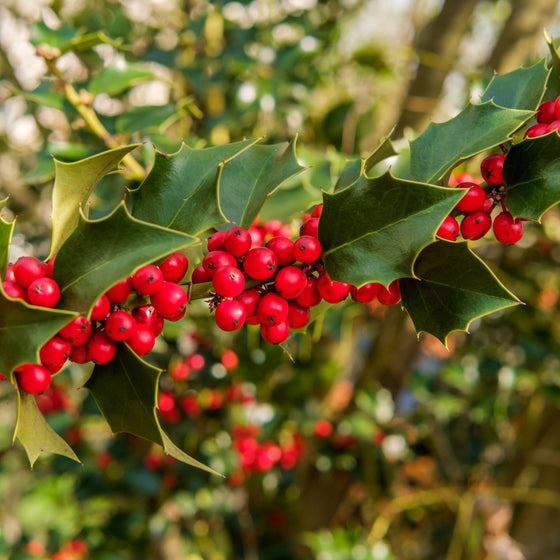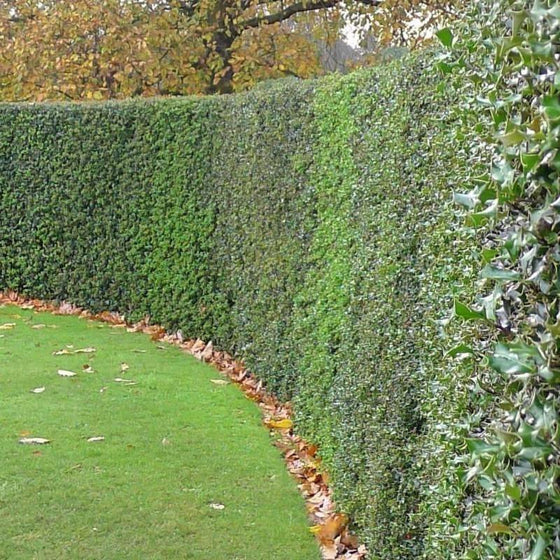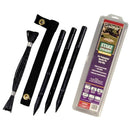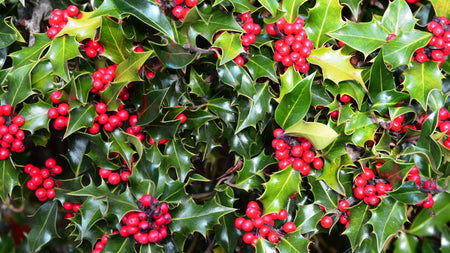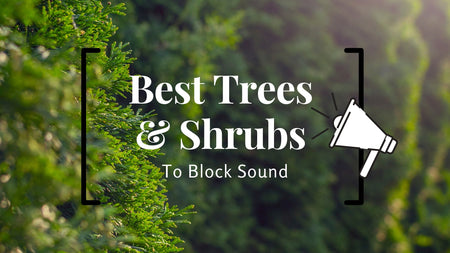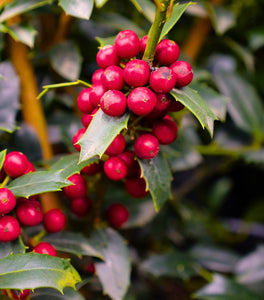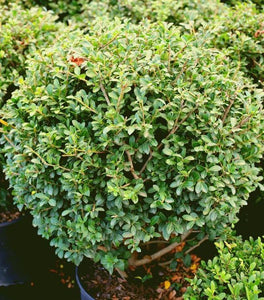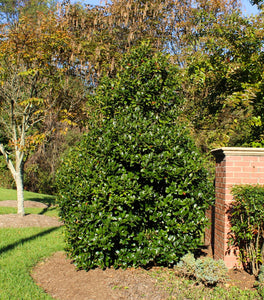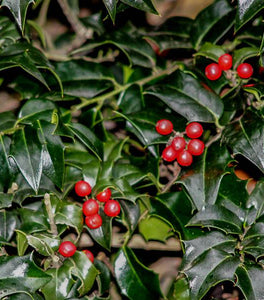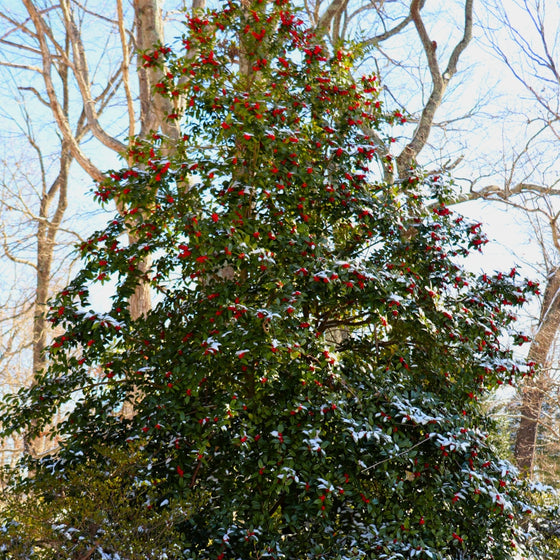
Images Depict Mature Plants
American Holly Tree for Sale Online
Elevate any landscape with the lustrous and vibrant specimen that is the American Holly Tree!
American Holly Trees (Ilex opaca), also known as Yule Holly, White Holly, or Christmas Holly, are beautiful, fast-growing evergreen trees that keep their vibrant, deep green color all year long!
Additional notable qualities of these gorgeous landscaping staples include a uniform pyramidal shape and bright red berries in the winter! The red glow of the berries contrasts nicely with the green leathery foliage and makes a beautiful ornamental tree. As an added bonus, birds love the holly berries and will be attracted to your landscape during the winter!
The evergreen Holly Tree is dioecious, meaning separate trees will have either male or female flowers, but not both. In order to produce berries, a male cultivar must be near a female tree so pollinators can do their work.
Native to the rich bottomlands and swamp margin areas of the eastern and central U.S., these prickly holly plants grows best in moist atmospheres and loamy, acidic, well-draining soil. These trees also enjoy conditions of full sun and will happily tolerate harsh winter winds.
The elegant plant not only provides a pleasant view to onlookers but also works to provide nectar for pollinators. Holly Trees also make great privacy hedges due to their sizeable pyramidal shape and ability to remain a lush green year-round.
Additionally, people often use Holly Trees as foundation plantings. The American Holly adds a festive touch to any outdoor space throughout the winter holidays.

| Hardiness Zone: | 6-9 |
|---|---|
| Mature Height: | 15 to 20 feet |
| Mature Width: | 12 to 15 feet |
| Sunlight: | Full sun to part shade |
| Foliage Color: | Dark green |
| Growth Form: | Upright pyramidal |
| Soil Conditions: | Very tolerant of most soil conditions |
How to Care for American Holly
Be sure to read about the recommended care instructions to keep this plant healthy and thriving!
What type of fertilizer is best for an American Holly Tree?
We recommend when planting your American Holly Trees to use Bio-tone starter fertilizer by Espoma. We have tested many so-called “starter fertilizers” over the years and have come to rely on Bio-tone exclusively for our own use. Simply mix the recommended amount of Bio-tone into the backfill soil and water in generously when back filled. Bio-tone® Starter Plus is an all-natural plant food that is combined with a stronger concentration of beneficial bacteria along with both endo and ecto mycorrhizae. Basically the “good” fungus in Bio-tone colonizes on the growing roots of your newly planted plant and does not allow disease causing fungus to attack the new roots. It has also shown promise in stimulating the growth of the new roots which means quicker establishment for your plant. After establishment and during the following years we recommend Holly-tone used at the recommended rates. It is also an organic and slow release which will feed your trees the proper amount of nutrients over a period of time rather than all at once which can burn the root tips and actually have the opposite effect of slowing down plant growth. It also will help to maintain the acid level in the soil that American Holly trees need to thrive.

When do I prune an American Holly?
Shearing of American Holly Trees is generally not needed however for a formal hedge start shearing when the tree reaches 3 or 4 feet tall in height, cutting only the sides, removing no more than 3 or 4 inches of growth. This will cause the tree to grow thicker. If you want the tree to grow tall don't cut the top leader, just shape the sides. The best time to shear is after a new growth spurt finishes and the new growth begins to mature. Growth will go from a smooth, greasy texture, to a rougher snake skin look. Shearing twice a year is sufficient but only if needed. To keep your trees at a particular height requires cutting the central leader and then shearing all outside branches. This will control the tree for many years, but in time the tree will become too large to maintain. Pruning can help make American Holly more bushy. It is recommended that you disinfect your shears before you begin and even after each plant to prevent disease spread. You can prune dead or diseased limbs anytime of the year. To encourage thick bushy trees simply trim back the limbs that have outstretched the rest of the tree.
How often do I water my Holly Tree?
To help your American Holly tree's roots to establish, apply 2-3 gallons of water for each inch of trunk in diameter several times a week. Do not add water if the root ball is saturated. Follow this schedule for 3-6 months depending on the USDA Zone you live in. Once established, apply 1 gallon a week to the root ball. You can discontinue irrigation once the deciduous trees in your area have dropped their leaves. You should try to moisten the soil 2-3 feet deep each time you irrigate. Depending on the soil condition, you may need more or less water. Clay for instance is more difficult to saturate and requires adding the water more slowly, while sandy soil absorbs water quickly. Keep this in mind when watering your newly planted tree. It is best to water your tree with a soaker hose, not a sprinkler.
How do I plant an American Holly Tree?
Never plant native American Holly Trees deeper than originally planted in the pot. As a rule we always say that before you mulch you should still be able to see the soil from the original pot. Planting too deep can cause rotting of the stem and death to the tree. American Holly are moderately drought tolerant; however, they grow very slow without adequate water. Staking young trees is recommended to minimize the stress on the stem from winds blowing the tree. When tying trees to stakes remember the tree will continue to grow. Loosely tie the tree with several twist ties to allow for growth. Check trees every three months and loosen as needed. If this is not done, the twist tie will grow into the tree causing injury. A Pro tip that we can offer is to use a short length of old garden hose and run the tie wire through the hose. This will protect the trunk of the tree from being damaged by the tie wire. The one question that comes up often when talking to customers is “when is the best time to plant trees?" For the most part, container trees can be planted year around, provided the ground isn’t frozen. Below Virginia, many nurseries and Christmas tree growers field plant year around, weather permitting. When planting a potted tree, remember the only water source the tree has, is its small root ball, and all the water the tree uses must come from them until new roots can grow into the surrounding soil. New trees should be watered twice weekly (Minimum), under hot drier conditions possibly more. Care should be taken not to over water. More trees die from over watering than under.

